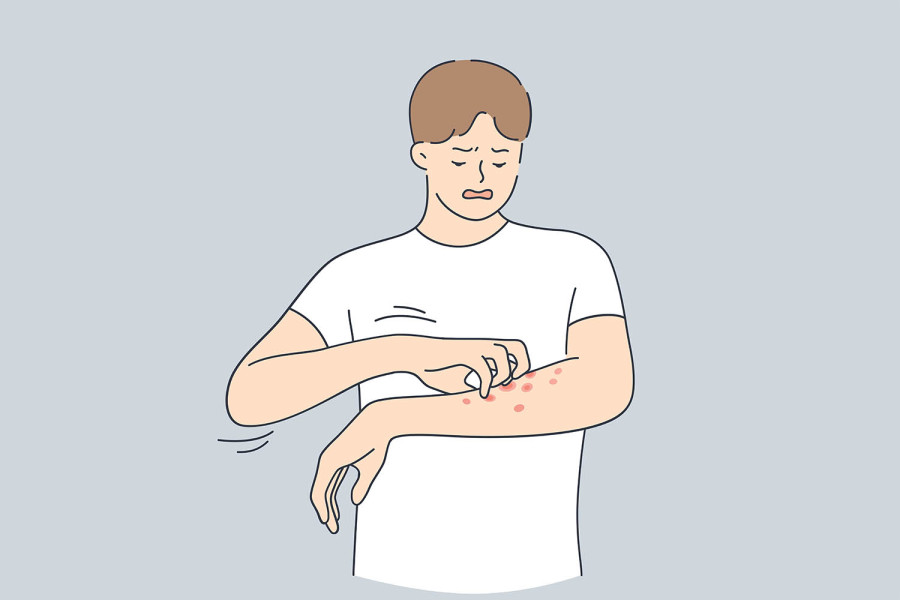Culture & Lifestyle
A guide to managing keratosis pilaris
Dr Tapan Pradhan explains the skin condition, its causes and treatment tips, mainly during the winter.
Timila Maharjan
Dr Tapan Pradhan, a dermatologist and hair transplant surgeon at Venus Skin and Hair Clinic in Biratnagar, offers insights into the causes and treatments of keratosis pilaris.
What is keratosis pilaris?
Keratosis pilaris, or follicular keratosis, is a common skin condition characterised by follicular keratotic papules (small bumps at the hair follicles) and perifollicular erythema (redness around the hair follicles). Although medically harmless, more widespread atypical cases may also be cosmetically disfiguring and psychologically distressing.
Keratosis pilaris occurs when there is an excess of keratin and a buildup of keratin around the hair follicles due to abnormal keratinisation (in simple words, the formation process of epidermal skin is faulty).
The individual follicular bumps are often caused by hair that cannot reach the surface and becomes trapped beneath the keratin debris. The exact cause behind the abnormal keratinisation is still not known.
Who is most likely to develop this disorder? Is it hereditary?
Keratosis pilaris often presents in the first decade of life and may worsen around puberty. In some patients, the disorder improves with age. Females appear to be more frequently affected than males.
Keratosis pilaris is often found to run in the family. It frequently occurs in genetically predisposed individuals and is more common among twins and siblings. Autosomal dominant inheritance of the condition is often described with variable penetrance.
What are its symptoms?
The main symptom is small, slightly hard bumps, often referred to as chicken skin or goose bumps, on the outer aspect of the limbs, particularly the arms and thighs. The buttocks and lumbar areas are also affected. Excessive scratching may cause secondary infection, often forming pustules. Some variants of keratosis pilaris can occur on the face, causing redness, hyperpigmentation, atrophic scarring, and hair loss in the affected areas.
Are there any environmental or lifestyle factors that contribute to keratosis pilaris?
This disorder may show seasonal variation, improving in the summer and worsening in winter. Inappropriate or frequent scrubbing/exfoliation of skin, using harsh products, and inadequate use of moisturisers during dry seasons may exacerbate keratosis pilaris.

Is keratosis pilaris linked to other conditions?
Keratosis pilaris is often associated with other disorders of keratinisation, such as ichthyosis vulgaris and atopic dermatitis. It has also been associated with various conditions, such as Insulin‐dependent diabetes (seen in types 1 and 2), hypothyroidism, Cushing syndrome, obesity or high body mass index, and Down syndrome.
It can occur in several nutritional deficiencies, among which vitamin A deficiency is the most common. Some rare types of keratosis pilaris, like Atrophoderma vermiculatum and Ulerythema Ophryogenes, may be associated with genetic conditions like Noonan syndrome, Cardio‐facio‐cutaneous syndrome, Fairbanks syndrome, Olmsted syndrome, Monilethrix, Pachyonychia congenita, and Ectodermal dysplasias, etc.
It has also been associated with the use of some drugs like Systemic corticosteroids, Lithium, Vemurafenib and sorafenib.
Are there any treatments that can improve this disorder?
The treatment for keratosis pilaris is continuous. The condition needs to be maintained. General measures to prevent excessive skin dryness, such as using mild soapless cleansers, are recommended, and lubrication or moisturiser use is the mainstay of treatment for nearly all cases.
Best results may be achieved with combination therapy. Mild cases may benefit from moisturisers along with creams with keratolytics like salicylic and lactic acids. In more severe cases, the dermatologist may prescribe Topical retinoids to reduce hyperkeratosis and combine them with urea-containing moisturisers.
Severe and complicated cases may require systemic isotretinoin after thorough evaluation. Similarly, issues like severe inflammation, infection, hyperpigmentation or scars may need to be addressed.
No single therapy is uniformly effective in all people, so evaluation by a certified dermatologist is critical. So that he/she can determine the best possible treatment regimen for your condition.
How do you recommend managing keratosis pilaris during winter?
As the condition worsens during winter, special care must be given to prevent skin dryness. It is advisable to limit hot showers; instead, opt for lukewarm water and do not extend the bath time to more than five minutes.
I recommend using soap-free cleansers and avoiding harsh soaps, excessive exfoliation, and scrubbing. It is imperative to use moisturisers after every bath. Liberally applying the prescribed moisturisers two to three times a day over the affected areas and using humidifiers indoors can be beneficial. Also, drink plenty of water to stay hydrated.




 20.12°C Kathmandu
20.12°C Kathmandu















